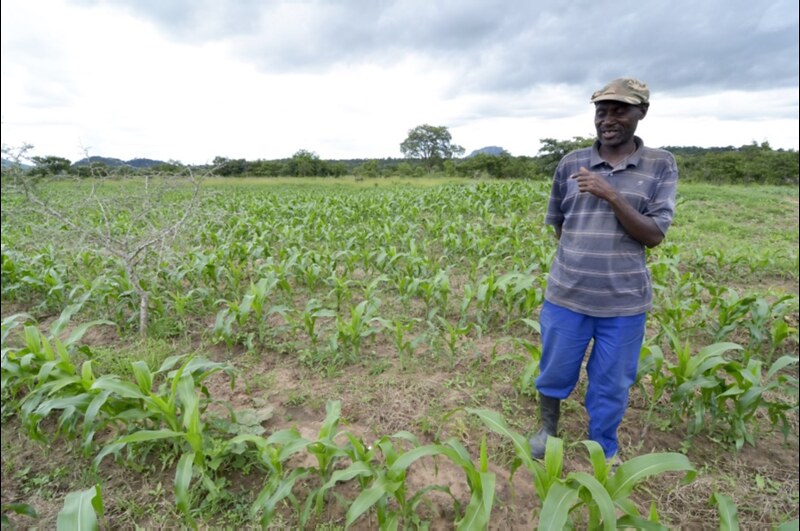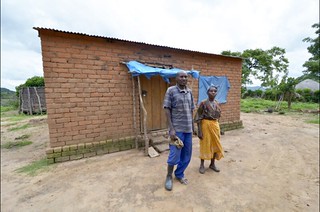Conservation agriculture is giving us more food and money: A Zambian farmer’s story

Conservation agriculture (CA) – also called ‘agricultural environmental management’ – is defined by the Food and Agriculture Organization of the United Nations (FAO) as ‘a concept for resource-saving agricultural crop production that strives to achieve acceptable profits together with high and sustained production levels while concurrently conserving the environment’. In the light of a booming population, CA has become critical over the years as more food needs to be produced annually to meet ever-growing demands. This scenario is especially pronounced in Africa where stagnant productivity, shrinking resources, expanding population, environmental degradation and a changing climate threaten the livelihoods and food security of millions of agriculture-based households.
Under the SIMLEZA-Africa RISING project, the implementation of CA technologies is a key intervention. For just the past 2 years, the project has already seen positive outcomes on the practices and lives of its farmer-beneficiaries in its target communities in the Eastern Province of Zambia. Below we highlight one of our farmer ‘success stories’ who have been practicing CA technologies introduced in the country by the project.
Damiano Tembo, Kafwumbwe Camp, Katete District
‘I first heard about the [SIMLEZA-Africa RISING] project during the community sensitization meetings conducted by staff from the Ministry of Agriculture. And although I have heard of CA before from my fellow farmers under the Conservation Farming Unit (CFU), I have never tried my hand in it,’ began Damiano Tembo, a SIMLEZA farmer-beneficiary.
‘After the sensitization activities, the SIMLEZA project staff and agricultural extension officers conducted another training on CA technologies, particularly the use of dibble sticks, in which I also participated,’ he added. ‘This ignited my interest especially when they explained the benefits that I could derive from practicing CA compared to using traditional farming methods.’
Tembo, who is also an active community volunteer, has five plots which serve to compare the different CA technologies and practices such as the use of dibble sticks and rippers, herbicides, basins, and hybrid seeds. In his first plot, on which he planted maize, he practices what he calls ‘old’ – or conventional – way of farming. In his second plot, which is also planted to maize, he uses dibble sticks in planting and has set up ‘basins’ for water retention. In his third plot, he also practices the use of dibble stick and intercropping maize with cowpea. In the fourth and fifth plots, Tembo uses dibble stick while rotating maize and cowpea. In all the CA plots, he applies herbicide to manage weeds.
He further explained that for the fourth and fifth plots, he rotated maize and cowpea interchangeably. ‘During the first year of planting under CA, I planted cowpea in my fourth plot and maize in my fifth. The following year (2013-2014 season), I reversed the crops – maize to replace cowpea in my fourth plot and cowpea to replace the maize in the fifth plot. Next year, I will reverse the crops again.’
Asked what he has observed as immediate benefits of CA over traditional farming, Tembo says, his CA plots yield much more than the traditional plot (first plot). ‘During my first harvest under SIMLEZA-Africa RISING, I only harvested two 50kg bags of maize from my conventional plot, compared to about four 50kg bags from each of my CA plots,’ he says.
He adds that “from the previous season, I got 40 50kg-bags/ha of maize from my conventional plot, while I got about 80 50kg-bags/ha of maize from each of my CA plots. This is double my usual harvest!’.
Because he uses herbicides in the CA plots as espoused by the project, Tembo spends less time and labour weeding, enabling him to pursue other income-generating activities. He sprays herbicide at the start of the planting season to control the growth of weeds and he devotes time saved to other crops that required additional manual labour such as cotton, sunflower and groundnuts. ‘Basically, with CA, I now get more income for the same time and labour spent,’ he says.
Additionally, Tembo has observed that in the CA plots, grass is growing better indicating much healthier soils. The use of CA retains soil nutrients leading to much better yields from crop-rotated CA plots compared to the conventional monocropped areas.
‘In the CA plots where I have ‘basins’, the soil stays wet longer than in my conventional plot. This, to me, is evidence of better soil moisture retention under CA, which is beneficial to my crops,’ he says.

So what has he do with the extra income from CA?
‘From the extra earnings I got from last season, I bought fertilizer from the cooperative, which I have used for the current season. I also used some of the money to pay for my children’s school fees, to buy some livestock such as cattle and goats, to buy food and other household items and to extend my house,’ he says. ‘My family is very happy!’.
Asked if he has shared his knowledge and experience of CA with other farmers in his community, Tembo replied that during the 2012-2013 season, ‘I taught about 40 farmers on the use of CA and the use of hybrid seeds, which is another practice being encouraged by SIMLEZA-Africa RISING. He is planning to continue sharing knowledge gained from the project with others.
Written by Jeffrey Oliver (IITA)




